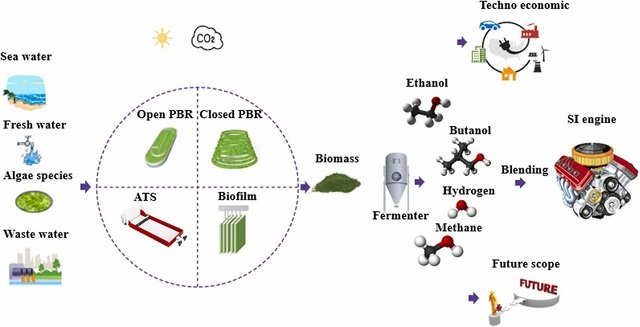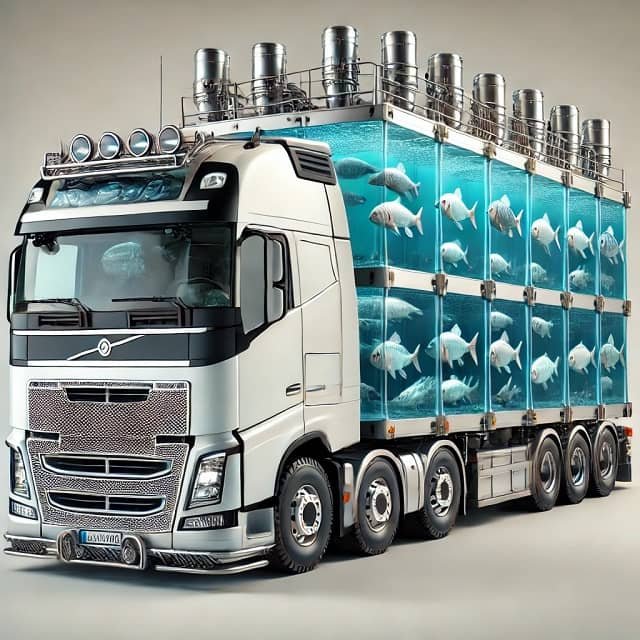
The Race for Sustainable Energy Solutions Has Begun, and Microalgae Are Emerging as a Key Player in Biofuel Production. Often referred to as “green gold,” these microscopic aquatic organisms have immense potential to produce biofuels, a clean and renewable alternative to fossil fuels. However, large-scale microalgae cultivation faces challenges, including land limitations and the high cost of transporting CO2, a vital ingredient for growth.
In a recent study published in the journal Energies by scientists from Dankook University (South Korea), the cultivation of the microalgae strain Chlorella sorokiniana under environmental CO2 conditions with the addition of CaCO3 was reported, and the results were compared with conventional cultivation with a 5% CO2 supply. The study measured biomass concentration, lipid content, and carbonic anhydrase (CA) activity, among other parameters. The findings confirmed that this innovative approach could serve as an effective Direct Air Capture (DAC) technology, applicable to large-scale cultivation to reduce atmospheric CO2 emissions and produce valuable products.
Challenges in Microalgae Cultivation
Extensive research is being conducted to optimize microalgae cultivation at all stages, from initial growth to processing and fuel production. While microalgae offer a promising solution for global energy demands, challenges remain. Finding suitable cultivation sites with enough space and economically transporting the essential ingredient, CO2, are significant obstacles.
Optimizing the cultivation conditions of microalgae has also been a focus of recent studies. By adjusting nitrogen and phosphorus concentrations in the culture medium and supplying a controlled amount of CO2, researchers have successfully increased biomass production and the carbon-fixing capacity of microalgae. However, it is important to note that these methods primarily address future CO2 emissions rather than the CO2 already present in the atmosphere.
On the other hand, direct air capture (DAC) technology, combined with microalgae cultivation, presents a more effective strategy for mitigating existing atmospheric CO2. Unlike trees, which absorb CO2 at a slower rate, microalgae can quickly convert CO2 into bicarbonate (HCO3−), which is rapidly absorbed by the cells and used for growth.
The Challenge of CO2 Supply
A major hurdle in large-scale cultivation is the need for a constant CO2 supply. Traditional methods involve capturing CO2 from industrial sources and transporting it to cultivation sites, a costly and energy-intensive process. This not only affects the overall sustainability of microalgae biofuels but also limits scalability.
The Power of Air: A Turning Point
New research sheds light on a promising alternative. A recent study demonstrates that microalgae can effectively utilize atmospheric CO2 for growth, eliminating the need for costly CO2 supplements. This breakthrough relies on the use of calcium carbonate (CaCO3), a readily available and inexpensive mineral.
Using CaCO3 as a CO2 replacement source in photosynthetic microalgae cultures enhances this process, allowing large amounts of CO2 to remain available for cell absorption over a longer period.
Stay Always Informed
Join our communities to instantly receive the most important news, reports, and analysis from the aquaculture industry.
Calcium Carbonate: The Secret Weapon
The study focused on Chlorella sorokiniana, a microalgae species known for its potential as a biofuel. When cultivated in air cultures supplemented only with 5 mM of CaCO3, C. sorokiniana achieved remarkable results:
- Stable pH levels: CaCO3 effectively buffered the culture medium, preventing the drastic pH increase often seen in air cultures. Uncontrolled pH fluctuations can hinder microalgae growth.
- Increased biomass production: Compared to the control group (air only), the CaCO3-supplemented cultures showed an astounding 17.68-fold increase in biomass concentration.
- Higher lipid content: The study also observed a 9.58-fold increase in the lipid content of microalgae cultured with CaCO3. Lipids are crucial building blocks for biofuel production.
Scaling Up for Sustainability
These findings are highly promising for large-scale and commercially viable microalgae cultivation. By leveraging readily available CaCO3 and utilizing atmospheric CO2, this method eliminates the need for costly infrastructure and reduces the environmental footprint of biofuel production.
Laboratory-Scale Success: The research further validated the effectiveness of CaCO3 supplementation in a larger-scale environment. Cultures grown with 5 mM of CaCO3 under similar conditions showed a 9-fold increase in biomass and a 7.15-fold increase in lipid content compared to air-only cultures.
The Future of Microalgae Biofuels
Cultivating microalgae with CaCO3 has the potential to revolutionize the biofuel landscape. This technology paves the way for a more sustainable and scalable future for biofuel production by minimizing costs and maximizing resource efficiency.
Reference (open access)
Pyo, Seonju, Byung-Sun Yu, and Kyudong Han. 2024. “Development of an Effective Microalgae Cultivation System Utilizing CO2 in the Air by Injecting CaCO3” Energies 17, no. 17: 4475. https://doi.org/10.3390/en17174475
Editor at the digital magazine AquaHoy. He holds a degree in Aquaculture Biology from the National University of Santa (UNS) and a Master’s degree in Science and Innovation Management from the Polytechnic University of Valencia, with postgraduate diplomas in Business Innovation and Innovation Management. He possesses extensive experience in the aquaculture and fisheries sector, having led the Fisheries Innovation Unit of the National Program for Innovation in Fisheries and Aquaculture (PNIPA). He has served as a senior consultant in technology watch, an innovation project formulator and advisor, and a lecturer at UNS. He is a member of the Peruvian College of Biologists and was recognized by the World Aquaculture Society (WAS) in 2016 for his contribution to aquaculture.




